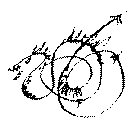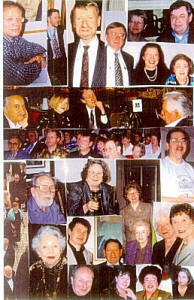|
FOR IMMEDIATE RELEASE
Opera on Florida’s Gulf Coast: A
Report
Coppola's Sacco and Vanzetti
at Tampa Opera
Verdi's Oberto at Sarasota Opera
by Laurie Shulman © 2001
Ask most Americans what was the trial of the century - the twentieth
century- and they’ll probably suggest O.J. Simpson’s in a knee-jerk
reaction. For several generations preceding our own, however, the answer
would have been the Sacco and Vanzetti trial of 1926. Italian immigrants
who lived outside Boston, Nicola Sacco and Bartolomeo Vanzetti were
apprehended after a double murder and theft at a shoe factory in April
1920. They were tried and convicted in June 1921, and executed by electric
chair after numerous appeals on 22 August, 1927. The case created an
international uproar, prompting accusations of prejudice against
immigrants, persecution on the basis of political beliefs (both defendants
were avowed anarchists), and a corrupt justice system. Modern scholars and
researchers now believe that both men may have been innocent, and that
Vanzetti certainly was.
The Italian-American conductor and composer Anton Coppola came of age
in the 1920s. He remembers discussions after dinner among his parents and
their friends, all Italian immigrants, discussing the case heatedly. The
topic haunted him for years, and he finally set it to music as an opera
last year. The world premiere performances took place 16-18 March at Opera
Tampa; the composer conducted the Florida Orchestra. Matthew Lata
directed.
Coppola’s opera Sacco and Vanzetti, which appears to have been a lifelong labor of love,
consists of a prologue and two acts. The libretto is in two languages, or
three if you count the Italian dialect of the title roles. The production
employed supertitles for both English and Italian, and the bilingual
approach lent a surprising and welcome element of realism to the
production.
From the opening measures of the overture, Coppola showed himself to be
a polystylist and an eclectic, of cultures, of musics and ideas. One hears
allusions to popular Italian tunes such as “Carnival of Venice” in his
music, but also references to Broadway in the 1920s, Tchaikovskyan
heart-on-sleeve, and an occasional flirtation with screaming dissonance.
(The executions toward the opera’s close were brutally effective in that
regard.) Both music and staging emphasized a collage of violence and
death, providing a subtle undertext that this was a way of life in the
1920s. Emile Fath as Vanzetti and Jeffery Springer as Sacco showed
strength and sensitivity in their difficult and demanding roles, although
Springer (who had been hospitalized for dehydration just days before
opening night) sounded a bit pinched in his upper register.
Matthew Lata’s production made extensive use of newspaper banner
headlines and ancient photographs of run-down neighborhoods. In the key
crime scene sequence, he used footage from an Italian film made in the
1970s about the case; Coppola scored that scene for orchestra alone. One
impressive first act scene employed an on-stage Italian banda,
serving as a catalyst for both romantic plot development and an animated
crowd sequence expressing solidarity among anarchists.
Coppola apparently came into his two-and-a-half week production cycle
prepared to cut, but not to revise. Although he acknowledged he had
shortened the score considerably, the opera, which had an 8:00 p.m.
curtain, did not let out until 11:30 on opening night. It could stand more
trimming, particularly a static scene among such Boston female literati as
Katharine Anne Porter and Edna St. Vincent Millay.
The future of operas such as Sacco and Vanzetti is uncertain.
Opera is expensive to produce, and opera topics derived from actual
historical events demand a composer who can bring its human elements to
life. “You have to make it soar lyrically, and find the moments to do
it,” Coppola observed at a press conference in March. “Otherwise it
becomes a dry history lesson.” His success in this opera was mixed, in
large part because the dramatic thrust was waylaid by its length. Opera
Tampa, however, did a splendid job in mounting the production and bringing
Matthew Lata’s imaginative staging ideas to life. The Florida Orchestra
played more than creditably in the pit with a new and unfamiliar score. Sacco
and Vanzetti was an ambitious undertaking. This is clearly an opera
company to watch.
 Opera Tampa’s 2001/2002 season includes Die Fledermaus, Basically
Bernstein (including Trouble in Tahiti and other concert
performances), and Rigoletto. Call Tampa Bay Performing Arts Center
at 813/222.1000 or www.tbpac.org. Opera Tampa’s 2001/2002 season includes Die Fledermaus, Basically
Bernstein (including Trouble in Tahiti and other concert
performances), and Rigoletto. Call Tampa Bay Performing Arts Center
at 813/222.1000 or www.tbpac.org.
* * *
Sarasota, about an hour and a half drive south of Tampa, has an
ambitious opera company of its own. This spring, the Sarasota Opera
reached the halfway point in its presentation of all Verdi’s music
undertaken in 1989. The 2001 offerings included the Requiem and
productions of Falstaff and Oberto, conte di San Bonifacio.
The latter, Verdi’s first opera, was too rare an opportunity to miss,
rather like having the chance to see a production of Wagner’s Die
Feen. First performed at La Scala in November 1839, Oberto is a
tale of love, virtue, deception, and revenge, all familiar topics in Verdi
(and indeed in opera). The plot has a father/daughter relationship that
foreshadows those of Rigoletto and Simon Boccanegra. Not
surprisingly, the score has more than its share of oom-pah-pah
accompaniment and some bland segments. Nevertheless, the seeds of genius
are present. In the most impressive ensemble, a dramatic quartet, the
music unfolds one vocal line at a time, rather than in polyphony, until
each character has had his say. While this hardly approaches the mastery
of the Rigoletto quartet, the gift is there.
The Sarasota troupe performs in a little jewel of a opera house,
reconstructed from a 1926 Mediterranean revival theater and seating only
1033. Unfortunately, the singers did not capitalize on the potential for
dramatic intimacy possible in such a space. For the most part they
oversang, apparently too accustomed to giant opera houses and directors
constantly telling them to project. As a result, Mariana Karpatova as
Cuniza, Roy Cornelius Smith as Riccardo, Rosa Baker as his daughter
Leonora (yes, another Leonora), and Halina Avery as Cuniza’s confidante
Imelda, all pushed, strained, and occasionally bellowed, resulting in an
unfortunate imbalance with Victor De Renzi and the Sarasota Opera
Orchestra. The exception was Kevin Short in the title role. His warm, rich
bass-baritone did much to redeem a vocally flawed performance.
Sarasota has a reputation for interesting, if traditional, stagings.
Director Dale Morehouse (well known to Dallas audiences as Director of
Opera at SMU), Scenic Designer John Farrell, and Costume Designer Howard
Tsvi Kaplan delivered an opulent and visually appealing production that
drew applause from the capacity audience every time the curtain rose on a
new scene. In a work that is so unfamiliar, realistic, colorful and richly
detailed stage sets are most welcome. With all the Eurotrash spareness and
shadows we have seen in recent years, it was a pleasure to get acquainted
with this unfamiliar opera, here garbed in a way that Verdi and his
librettist, Temistocle Solera, would have recognized.
 The Sarasota Opera’s 43rd Season in February and March 2002
includes Il trovatore in the 1857 French version (as Le
Trouvère); Lucia di Lammermoor, Così fan tutte, Ariadne
auf Naxos, and a special concert entitled An Evening of Verdi
Choruses. Tel. 941/366.8450 or www.sarasotaopera.org. The Sarasota Opera’s 43rd Season in February and March 2002
includes Il trovatore in the 1857 French version (as Le
Trouvère); Lucia di Lammermoor, Così fan tutte, Ariadne
auf Naxos, and a special concert entitled An Evening of Verdi
Choruses. Tel. 941/366.8450 or www.sarasotaopera.org.
Founded in 1992 by Virginia Richey Abdo and Dr. James T. Wheeler, the
Wagner Society of Dallas has had an active
presence in the musical life of Dallas since that time. As the WSD continues to grow and expand, it is having a wider and wider influence
among musicians and performing arts institutions in North Texas,
as well as with music lovers throughout the Metroplex area. The Wagner
Society of Dallas is now creating a presence on the internet as a tool to promote
the music of Richard Wagner, and classical music in general, to the widest possible audience.
Through the medium of its own web page, regular meetings, participation in
musical events in the Dallas area, and attendance at opera performances
across the country and around the world, the Wagner Society of Dallas is
becoming an important source
of Wagner information on the World Wide Web.
|




